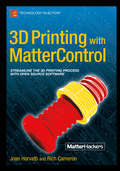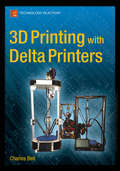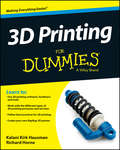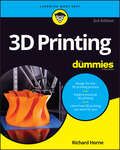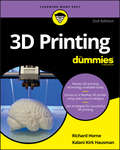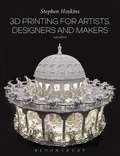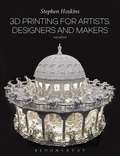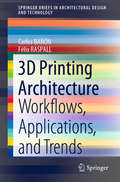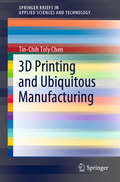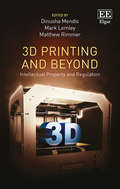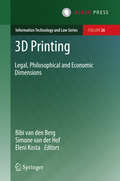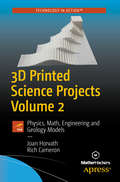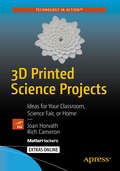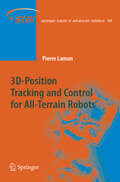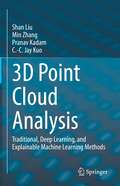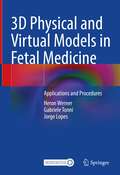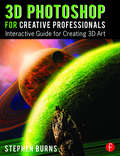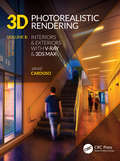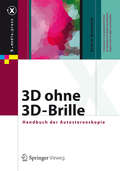- Table View
- List View
3D Printing with MatterControl
by Joan Horvath Rich CameronIn 3D Printing With MatterControl, Joan Horvath and Rich Cameron, the team behind Mastering 3D Printing, explain step-by-step how to use the MatterControl program, which allows you to control many common types of 3D printers (including both cartesian and delta style machines). 3D Printing With MatterControl can stand alone, or it can be a companion to Mastering 3D Printing to show you how to install, configure, and use best practices with your printer and printing software. The book includes both step by step software walkthroughs and case studies with typical 3D printed objects.Whether you are a "maker" or a teacher of makers, 3D Printing with MatterControl will show you how to get the most out of your printer with the new standard for open source 3D printing software.While there are books available on 3D printers, and even a few on software to make models for printers, there are few good sources covering the software that actually controls these printers. MatterControl is emerging as the leading open source software for 3D printers, and 3D Printing With MatterControl covers this new standard in this brief book.
3D Printing with Fusion 360: Design for additive manufacturing, and level up your simulation and print preparation skills
by Sualp OzelImprove your Autodesk Fusion competence around 3D printing workflows by learning how to repair broken STLs, design for additive manufacturing, position and support parts, and slice themKey FeaturesUse Autodesk Fusion to import and repair external designs and create native lightweight designs for 3D printingMaster the setup of 3D printing within Fusion’s Manufacture workspaceGain insights into the different 3D printing technologies and the unique print preparation steps for their effective usePurchase of the print or Kindle book includes a free PDF eBookBook DescriptionAs 3D printing gains traction, the demand for CAD experts in manufacturing grows. If you're a fan of Autodesk Fusion and crave hands-on experience with automated modeling, generative design, and the full potential of additive manufacturing, this book is your guide to elevating your design and 3D printing skills. In this book, you’ll learn how to open CAD or Mesh files in Fusion and expertly repair, edit, and prepare them for 3D printing. You’ll unlock the secrets of effective print preparation, learning about print settings, support structures, and part orientation. This book also highlights Fusion’s diverse preferences designed specifically for additive manufacturing. Subsequent chapters will guide you in choosing the right part orientation and position, as well as creating suitable support structures based on your chosen printing technology. You’ll simulate the printing process to detect and remedy common print failures associated with the metal powder bed fusion process. Finally, you’ll leverage templates and scripts to automate routine tasks around print preparation. By the end of this 3D printing book, you'll be armed with the knowledge and skills necessary to harness the power of Fusion for additive manufacturing, meeting the growing demand with confidence.What you will learnUse Autodesk Fusion to open, inspect, repair, and edit externally created designs for 3D printingSet up your 3D prints for different printing technologies, such as FFF, SLA/DLP, SLS, and MPBFUse templates to automate your additive operations, including part orientation, arrangement, and supportRun process simulation for metal powder bed fusion and learn how to compensate for common print failure modesOptimize Fusion 360’s preferences for 3D printingExport machine-specific file formats for 3D printing, such as G-Code, SLI, SLC, and CLIWho this book is forIf you're a designer using Autodesk Fusion on a daily basis and want to delve into 3D printing or craft functional, lightweight prints, this book is your go-to. It's also a valuable reference for intermediate-level Fusion users seeking insights into DFAM (design for additive manufacturing) and print preparation. To get the most out of this book, it's recommended that you have a good understanding of Fusion's design features, familiarity with opening CAD or MESH files, and prior experience creating components in Fusion.
3D Printing with Delta Printers
by Charles BellDo you find yourself wondering what the fuss is about a delta 3D printer? Perhaps you’ve decided to buy one but all of your 3D printing friends are busily perfecting their Cartesian printers. Maybe you find yourself stymied by the fact that your delta printer has very different needs for setup, configuration, calibration, and maintenance than Cartesian printers.3D Printing with Delta Printers contains detailed descriptions of the innovative delta design including unique hardware, software, and maintenance requirements. The book also covers tips for building your own delta printer as well as examples of common enhancements.This book will enable you to build, configure, and enhance your delta printer. The topics covered will reveal the often-mysterious nuances of the delta design that will enable your printer to compete with the best of what your 3D printer friends can build.
3D Printing For Dummies
by Kalani Kirk Hausman Richard HorneGet started printing out 3D objects quickly and inexpensively! 3D printing is no longer just a figment of your imagination. This remarkable technology is coming to the masses with the growing availability of 3D printers. 3D printers create 3-dimensional layered models and they allow users to create prototypes that use multiple materials and colors. This friendly-but-straightforward guide examines each type of 3D printing technology available today and gives artists, entrepreneurs, engineers, and hobbyists insight into the amazing things 3D printing has to offer. You’ll discover methods for the creation of 3D printable objects using software, 3D scanners, and even photographs with the help of this timely For Dummies guide. Includes information on stereolithography, selective sintering, fused deposition, and granular binding techniques Covers the potential for the transformation of production and manufacturing, reuse and recycling, intellectual property design controls, and the commoditization of traditional products from magazines to material goods Walks you through the process of creating a RepRap printer using open-source designs, software, and hardware Addresses the limitations of current 3D printing technologies and provides strategies for improved success 3D Printing For Dummies is the must-have guide to make manufacturing your own dynamic designs a dream come true!
3D Printing For Dummies
by Kalani Kirk Hausman Richard HorneGet started printing out 3D objects quickly and inexpensively! 3D printing is no longer just a figment of your imagination. This remarkable technology is coming to the masses with the growing availability of 3D printers. 3D printers create 3-dimensional layered models and they allow users to create prototypes that use multiple materials and colors. This friendly-but-straightforward guide examines each type of 3D printing technology available today and gives artists, entrepreneurs, engineers, and hobbyists insight into the amazing things 3D printing has to offer. You’ll discover methods for the creation of 3D printable objects using software, 3D scanners, and even photographs with the help of this timely For Dummies guide. Includes information on stereolithography, selective sintering, fused deposition, and granular binding techniques Covers the potential for the transformation of production and manufacturing, reuse and recycling, intellectual property design controls, and the commoditization of traditional products from magazines to material goods Walks you through the process of creating a RepRap printer using open-source designs, software, and hardware Addresses the limitations of current 3D printing technologies and provides strategies for improved success 3D Printing For Dummies is the must-have guide to make manufacturing your own dynamic designs a dream come true!
3D Printing For Dummies
by Richard HornePrint out whatever you can dream up 3D Printing For Dummies is an easy reference for anyone new to the process of taking a digital file and turning it into an object in the real world. (Pretty amazing stuff, right?) It’s also a handy guide for more experienced users looking to learn the latest and greatest in additive manufacturing. Updated for the latest generation of machines and materials, this book walks you through creating models and printing 3D objects. You’ll get the scoop on the impact of these versatile machines in production and manufacturing, reuse and recycling, intellectual property design controls, and more. It’s an exciting time to get into 3D printing, and this friendly Dummies guide is here to help you do it. Wrap your mind around the technology of 3D printing Understand how 3D printing is transforming industries Get an intro to making your own digital models Consider the pros and cons of 3D printing for your hobby or business needs3D Printing For Dummies is a perfect resource for anyone interested in learning about and taking advantage of 3D printing technology.
3D Printing For Dummies
by Richard HornePrint out whatever you can dream up 3D Printing For Dummies is an easy reference for anyone new to the process of taking a digital file and turning it into an object in the real world. (Pretty amazing stuff, right?) It’s also a handy guide for more experienced users looking to learn the latest and greatest in additive manufacturing. Updated for the latest generation of machines and materials, this book walks you through creating models and printing 3D objects. You’ll get the scoop on the impact of these versatile machines in production and manufacturing, reuse and recycling, intellectual property design controls, and more. It’s an exciting time to get into 3D printing, and this friendly Dummies guide is here to help you do it. Wrap your mind around the technology of 3D printing Understand how 3D printing is transforming industries Get an intro to making your own digital models Consider the pros and cons of 3D printing for your hobby or business needs3D Printing For Dummies is a perfect resource for anyone interested in learning about and taking advantage of 3D printing technology.
3D Printing For Dummies
by Richard Horne Kalani Kirk HausmanThe bestselling book on 3D printing 3D printing is one of the coolest inventions we've seen in our lifetime, and now you can join the ranks of businesspeople, entrepreneurs, and hobbyists who use it to do everything from printing foods and candles to replacement parts for older technologies—and tons of mind-blowing stuff in between! With 3D Printing For Dummies at the helm, you'll find all the fast and easy-to-follow guidance you need to grasp the methods available to create 3D printable objects using software, 3D scanners, and even photographs through open source software applications like 123D Catch. Thanks to the growing availability of 3D printers, this remarkable technology is coming to the masses, and there's no time like the present to let your imagination run wild and actually create whatever you dream up—quickly and inexpensively. When it comes to 3D printing, the sky's the limit! Covers each type of 3D printing technology available today: stereolithology, selective sintering, used deposition, and granular binding Provides information on the potential for the transformation of production and manufacturing, reuse and recycling, intellectual property design controls, and the commoditization of products Walks you through the process of creating a RepRap printer using open source designs, software, and hardware Offers strategies for improved success in 3D printing On your marks, get set, innovate!
3D Printing For Dummies
by Richard Horne Kalani Kirk HausmanThe bestselling book on 3D printing 3D printing is one of the coolest inventions we've seen in our lifetime, and now you can join the ranks of businesspeople, entrepreneurs, and hobbyists who use it to do everything from printing foods and candles to replacement parts for older technologies—and tons of mind-blowing stuff in between! With 3D Printing For Dummies at the helm, you'll find all the fast and easy-to-follow guidance you need to grasp the methods available to create 3D printable objects using software, 3D scanners, and even photographs through open source software applications like 123D Catch. Thanks to the growing availability of 3D printers, this remarkable technology is coming to the masses, and there's no time like the present to let your imagination run wild and actually create whatever you dream up—quickly and inexpensively. When it comes to 3D printing, the sky's the limit! Covers each type of 3D printing technology available today: stereolithology, selective sintering, used deposition, and granular binding Provides information on the potential for the transformation of production and manufacturing, reuse and recycling, intellectual property design controls, and the commoditization of products Walks you through the process of creating a RepRap printer using open source designs, software, and hardware Offers strategies for improved success in 3D printing On your marks, get set, innovate!
3D Printing for Artists, Designers and Makers
by Stephen HoskinsFully revised and with a new chapter and international case studies, this second edition of the best-selling book traces how artists and designers continue to adapt and incorporate 3D printing technology into their work and explains how the creative industries are directly interfacing with this new technology. Covering a broad range of applied art practice – from fine art and furniture-design to film-making – Stephen Hoskins introduces some of his groundbreaking research from the Centre for Fine Print Research along with an updated history of 3D print technology, a new chapter on fashion and animation, and new case studies featuring artists working with metal, plastic, ceramic and other materials. A fascinating investigation into how the applied arts continue to adapt to new technologies and a forecast of what developments we might expect in the future, this book is essential reading for students, researchers studying contemporary art and design and professionals involved in the creative industries.
3D Printing for Artists, Designers and Makers
by Stephen HoskinsFully revised and with a new chapter and international case studies, this second edition of the best-selling book traces how artists and designers continue to adapt and incorporate 3D printing technology into their work and explains how the creative industries are directly interfacing with this new technology. Covering a broad range of applied art practice – from fine art and furniture-design to film-making – Stephen Hoskins introduces some of his groundbreaking research from the Centre for Fine Print Research along with an updated history of 3D print technology, a new chapter on fashion and animation, and new case studies featuring artists working with metal, plastic, ceramic and other materials. A fascinating investigation into how the applied arts continue to adapt to new technologies and a forecast of what developments we might expect in the future, this book is essential reading for students, researchers studying contemporary art and design and professionals involved in the creative industries.
3D Printing Architecture: Workflows, Applications, and Trends (SpringerBriefs in Architectural Design and Technology)
by Carlos BAÑÓN Félix RASPALLThis book investigates how architectural design advances as a result of the rapid developments in 3D Printing. As this technology become more powerful, faster and cheaper, novel workflows are becoming available and revolutionizing all stages of the design process, from early spatial concepts, to subsequent project development, advanced manufacturing processes, and integration into functional buildings. Based on a literature review and case studies of ten built projects, the book discusses the implications of the ongoing manufacturing revolution for the field of architecture.
3D Printing and Ubiquitous Manufacturing (SpringerBriefs in Applied Sciences and Technology)
by Tin-Chih Toly ChenThis book provides a thorough overview of the applications of 3D printing technologies to ubiquitous manufacturing (UM). UM itself represents an application of ubiquitous computing in the manufacturing sector, and this book reveals how it offers convenient, on-demand network access to a shared pool of configurable manufacturing resources, including software tools, equipment, and capabilities. Given its scope, the book will be of considerable interest to researchers in the areas of manufacturing, mechanical engineering, operations management, production control, ubiquitous computing, and sensor technologies, as well as practicing managers and engineers.
3D Printing and Beyond: Intellectual Property and Regulation
by Dinusha Mendis Mark Lemley Matthew RimmerThis ground-breaking and timely contribution in the field of intellectual property law explores the implications of 3D printing and additive manufacturing in three core jurisdictions: the UK, USA and Australia. Providing in-depth analysis of the current state of affairs, as well as outlining future issues and developments, 3D Printing and Beyond addresses both the challenges and opportunities created by 3D printing. Combining expertise from academia and practice, the original contributions to this book consider the regulation of new, emerging and future technologies and their implications for the legal landscape. The book goes beyond 3D printing and its relationship with intellectual property to the realms of ethics, contracts, socio-legal aspects and economics. Intellectual property academics will greatly benefit from reading this book, as it not only explores the myriad ways in which 3D printing has altered the horizon of intellectual property law, but also offers ideas for areas of future research. Practitioners and policy makers will also benefit from the useful examples and cases used in this book.
3D Printing: Legal, Philosophical and Economic Dimensions (Information Technology and Law Series #26)
by Bibi van den Berg Simone van der Hof Eleni KostaThe book in front of you is the first international academic volume on the legal, philosophical and economic aspects of the rise of 3D printing.In recent years 3D printing has become a hot topic. Some claim that it will revolutionize production and mass consumption, enabling consumers to print anything from clothing, automobile parts and guns to various foods, medication and spare parts for their home appliances. This may significantly reduce our environmental footprint, but also offers potential for innovation and creativity.At the same time 3D printing raises social, ethical, regulatory and legal questions. If individuals can print anything they want, how does this affect existing systems of intellectual property rights? What are the societal consequences of the various types of products one can print with a 3D printer, for example weapons? Should all aspects of 3D printing be regulated, and if so, how and to what ends? How will businesses (have to) change their way of working and their revenue model in light of the shift to printing-on-demand? How will the role of product designers change in a world where everyone has the potential to design their own products? These and other questions are addressed in high quality and in-depth contributions by academics and experts, bringing together a wide variety of academic discussions on 3D printing from different disciplines as well as presenting new views, broadening the discussion beyond the merely technical dimension of 3D printing.Bibi van den Berg is Associate Professor at eLaw, the Center for Law and Digital Technologies at Leiden University, The Netherlands. Simone van der Hof is Full Professor at eLaw in Leiden and Eleni Kosta is Associate Professor at TILT, the Tilburg Institute for Law, Technology and Society at Tilburg University, The Netherlands.
3D Printed Science Projects Volume 2: Physics, Math, Engineering and Geology Models
by Joan Horvath Rich CameronLearn physics, engineering, and geology concepts usually seen in high school and college in an easy, accessible style. This second volume addresses these topics for advanced science fair participants or those who just like reading about and understanding science. 3D Printed Science Project Volume 2 describes eight open-source 3D printable models, as well as creative activities using the resulting 3D printed pieces. The files are designed to print as easily as possible, and the authors give tips for printing them on open source printers. As 3D printers become more and more common and affordable, hobbyists, teachers, parents, and students stall out once they've printed some toys and a few household items. To get beyond this, most people benefit from a “starter set” of objects as a beginning point in their explorations, partially just to see what is possible. This book tells you the solid science stories that these models offer, and provides them in open-source repositories. What You Will LearnCreate (and present the science behind) 3D printed modelsReview innovative ideas for tactile ways to learn concepts in engineering, geology and physicsLearn what makes a models easy or hard to 3D printWho This Book Is ForThe technology- squeamish teacher and parents who want their kids to learn something from their 3D printer but don’t know how, as well as high schoolers and undergraduates.
3D Printed Science Projects: Ideas for your classroom, science fair or home
by Joan Horvath Rich CameronCreate 3D printable models that can help students from kindergarten through grad school learn math, physics, botany, chemistry, engineering and more. This book shows parents and teachers how to use the models inside as starting points for 3D printable explorations. Students can start with these models and vary them for their own explorations. Unlike other sets of models that can just be scaled, these models have the science built-in to allow for more insight into the fundamental concepts.Each of the eight topics is designed to be customized by you to create a wide range of projects suitable for science fairs, extra credit, or classroom demonstrations. Science fair project suggestions and extensive "where to learn more" resources are included, too. You will add another dimension to your textbook understanding of science.What You'll Learn Create (and present the science behind) 3D printed models.Use a 3D printer to create those models as simply as possible.Discover new science insights from designing 3D models. Who This Book Is ForParents and teachers
3D-Position Tracking and Control for All-Terrain Robots (Springer Tracts in Advanced Robotics)
by Pierre LamonRough terrain robotics is a fast evolving field of research and a lot of effort is deployed towards enabling a greater level of autonomy for outdoor vehicles. This book demonstrates how the accuracy of 3D position tracking can be improved by considering rover locomotion in rough terrain as a holistic problem. Although the selection of appropriate sensors is crucial to accurately track the rover’s position, it is not the only aspect to consider. Indeed, the use of an unadapted locomotion concept severely affects the signal to noise ratio of the sensors, which leads to poor motion estimates. In this work, a mechanical structure allowing smooth motion across obstacles with limited wheel slip is used. In particular, it enables the use of odometry and inertial sensors to improve the position estimation in rough terrain. A method for computing 3D motion increments based on the wheel encoders and chassis state sensors is developed. Because it accounts for the kinematics of the rover, this method provides better results than the standard approach. To further improve the accuracy of the position tracking and the rover’s climbing performance, a controller minimizing wheel slip is developed. The algorithm runs online and can be adapted to any kind of passive wheeled rover. Finally, sensor fusion using 3D-Odometry, inertial sensors and visual motion estimation based on stereovision is presented. The experimental results demonstrate how each sensor contributes to increase the accuracy and robustness of the 3D position estimation.
3D Point Cloud Analysis: Traditional, Deep Learning, and Explainable Machine Learning Methods
by Shan Liu Min Zhang Pranav Kadam C.-C. Jay KuoThis book introduces the point cloud; its applications in industry, and the most frequently used datasets. It mainly focuses on three computer vision tasks -- point cloud classification, segmentation, and registration -- which are fundamental to any point cloud-based system. An overview of traditional point cloud processing methods helps readers build background knowledge quickly, while the deep learning on point clouds methods include comprehensive analysis of the breakthroughs from the past few years. Brand-new explainable machine learning methods for point cloud learning, which are lightweight and easy to train, are then thoroughly introduced. Quantitative and qualitative performance evaluations are provided. The comparison and analysis between the three types of methods are given to help readers have a deeper understanding. With the rich deep learning literature in 2D vision, a natural inclination for 3D vision researchers is to develop deep learning methods for point cloud processing. Deep learning on point clouds has gained popularity since 2017, and the number of conference papers in this area continue to increase. Unlike 2D images, point clouds do not have a specific order, which makes point cloud processing by deep learning quite challenging. In addition, due to the geometric nature of point clouds, traditional methods are still widely used in industry. Therefore, this book aims to make readers familiar with this area by providing comprehensive overview of the traditional methods and the state-of-the-art deep learning methods. A major portion of this book focuses on explainable machine learning as a different approach to deep learning. The explainable machine learning methods offer a series of advantages over traditional methods and deep learning methods. This is a main highlight and novelty of the book. By tackling three research tasks -- 3D object recognition, segmentation, and registration using our methodology -- readers will have a sense of how to solve problems in a different way and can apply the frameworks to other 3D computer vision tasks, thus give them inspiration for their own future research. Numerous experiments, analysis and comparisons on three 3D computer vision tasks (object recognition, segmentation, detection and registration) are provided so that readers can learn how to solve difficult Computer Vision problems.
3D Physical and Virtual Models in Fetal Medicine: Applications and Procedures
by Heron Werner Gabriele Tonni Jorge LopesTechnological innovations accompanying advances in medicine have given rise to the possibility of obtaining better-defined fetal images that assist in medical diagnosis and contribute toward genetic counseling offered to parents during the prenatal care. 3D printing is an emerging technique with a variety of medical applications such as surgical planning, biomedical research and medical education.Clinical Relevance: 3D physical and virtual models from ultrasound and magnetic resonance imaging have been used for educational, multidisciplinary discussion and plan therapeutic approaches. The authors describe techniques that can be applied at different stages of pregnancy and constitute an innovative contribution to research on fetal abnormalities. We will show that physical models in fetal medicine can help in the tactile and interactive study of complex abnormalities in multiple disciplines. They may also be useful for prospective parents because a 3D physical model with the characteristics of the fetus should allow a more direct emotional connection to their unborn child.
3D Photoshop for Creative Professionals: Interactive Guide for Creating 3D Art
by Stephen BurnsPhotoshop is the cornerstone of the graphics industry and understanding its 3D capabilities is becoming a requirement for graphic designers, photographers, and creatives alike. Starting with the fundamental tools and ending with advanced resources, Adobe Community Professional Stephen Burns guides you with a clear voice and creative exercises that encourage you to work as you read. Accompanied by a free app that includes video tutorials, interactive models to compare your activity work from the book against, and on-going updates about the latest Photoshopreleases, this book will elevate your art off the page and into a new world of possibilities. (The app is available for the iPad and iPhone in the iTunes App Store, and Android users can find it through Google Play. Just search for 3D Photoshop on either of these platforms and download it to your device.)
3D Photoshop for Creative Professionals: Interactive Guide for Creating 3D Art
by Stephen BurnsPhotoshop is the cornerstone of the graphics industry and understanding its 3D capabilities is becoming a requirement for graphic designers, photographers, and creatives alike. Starting with the fundamental tools and ending with advanced resources, Adobe Community Professional Stephen Burns guides you with a clear voice and creative exercises that encourage you to work as you read. Accompanied by a free app that includes video tutorials, interactive models to compare your activity work from the book against, and on-going updates about the latest Photoshopreleases, this book will elevate your art off the page and into a new world of possibilities. (The app is available for the iPad and iPhone in the iTunes App Store, and Android users can find it through Google Play. Just search for 3D Photoshop on either of these platforms and download it to your device.)
3D Photorealistic Rendering: Interiors & Exteriors with V-Ray and 3ds Max (3D Photorealistic Rendering)
by Jamie CardosoIncrease the photorealism of your 3d visualizations with enhanced toolsets of V-ray in 3ds Max. Full-color, step-by-step tutorials about techniques involved in creating photorealistic renders for interior/exterior scenes. Each tutorial includes a 3d project scene to guide you through, production and post-production. The production chapter shows how to create shaders, fine-tune textures and set up a day/night lighting rig. You will be rendering high-res images with render elements included for the final stage of post-production. The book also includes tips about, pre-production, camera settings, verified views, material editors, shaders, 3ds max scripts, and much more! Key Features This book deals with real world scenes and delivers up to date design direction. This book has professional supporting files ready for the reader to open and explore. This book highlights the processes of making your own content that not only gives images your personal touch, but also through the online content that will be made available for this title. Includes some coverage of VRay. Focuses in depth on separate issues surrounding interior, exterior and product design, which vary wildly.
3D Photorealistic Rendering: Interiors & Exteriors with V-Ray and 3ds Max (3D Photorealistic Rendering)
by Jamie CardosoIncrease the photorealism of your 3d visualizations with enhanced toolsets of V-ray in 3ds Max. Full-color, step-by-step tutorials about techniques involved in creating photorealistic renders for interior/exterior scenes. Each tutorial includes a 3d project scene to guide you through, production and post-production. The production chapter shows how to create shaders, fine-tune textures and set up a day/night lighting rig. You will be rendering high-res images with render elements included for the final stage of post-production. The book also includes tips about, pre-production, camera settings, verified views, material editors, shaders, 3ds max scripts, and much more!
3D ohne 3D-Brille: Handbuch der Autostereoskopie (X.media.press)
by Armin GrasnickSeit dem kommerziellen Erfolg des 3D-Blockbusters „Avatar“ im Jahr 2009 kommen immer mehr 3D-Filme und 3D-Fernseher auf den Markt. Mittlerweile gibt es Autostereoskopie-Verfahren, bei denen Zuschauer keine 3D-Brille mehr benötigen. In dem Band werden die derzeit verfügbaren Technologien der Autostereoskopie, ihre Funktionsweise, Anwendung und Limitierung allgemeinverständlich beschrieben. Zu jeder Technologie liefert der Band Anleitungen und Beispiele für die Erstellung von 3D-Inhalten. Alle Tools sind auf der begleitenden Internetseite verfügbar.
